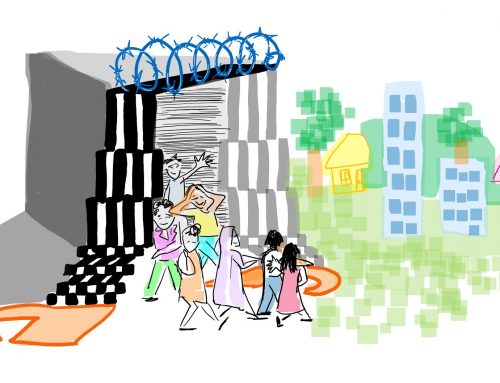Dr Anna Lindley
Senior Lecturer, Department of Development Studies, SOAS, University of London
Risk is a key ‘organizing concept’ for immigration control regimes and often comes up when talking about immigration detention. As one UK detention officer put it, ‘We are protecting the community’. Yet there is also abundant evidence of the harm detention can cause those targeted and their families. How is risk generally conceptualised and operationalized in detention decision-making? And how does this relate to the current Covid-19 situation – what happens when public health risk collides with immigration control risk? This blog draws on analysis set out in more detail in a forthcoming Migration Studies article, based primarily on policy documents, interviews with legal professionals, detention statistics, and inspection and research reports.
Removability is a core consideration in immigration detention decisions. The right to determine who may live on state territory, and to remove those that do not have that right, has long been viewed as an essential sovereign power and a means of protecting labour markets, public resources and the security of citizens. Yet how the state exerts removal powers has raised a range of issues, including the erosion of access to refugee protection, immigration raids penalising unauthorised workers more than employers, the UK’s historical and on-going involvement in global structural injustices driving much unauthorised migration, and the way that the byzantine legal framework and sceptical bureaucracy conspire to produce ‘illegality’. Putting these issues to one side, Home Office guidance is clear that people should only be detained where there is a ‘realistic prospect of removal within a reasonable period’. Yet what constitutes realistic and reasonable is not clearly defined. Legal and logistical obstacles may intervene and government statistics suggest that Home Office predictions are often considerably off the mark. Last year only 37% of people leaving detention were being put on a flight; the majority were being released back into the community. Thus ‘un-deportability’ is paradoxically a key feature of detention.
‘Immigration control risks’ also come into play in detention decisions. Here, the fear is that the migrants will fail to maintain contact with the authorities or cause harm to the public, if they are allowed to live in the community on bail restrictions. Legally, any form of ‘preventive incapacitation’ is supposed to prevent serious risks and require a high standard of proof. Home Office guidance directs officials to consider the individual’s immigration compliance record and the legal and personal circumstances of the people they detain, but it’s not clear what precise inferences are to be drawn about absconding risk from this, and lawyers and judges interviewed suggest that Home Office statements about absconding risk quite often don’t stand up to closer scrutiny. Meanwhile, foreign nationals scheduled for post-sentence deportation are typically further detained when they have finished their custodial sentence – sometimes for lengthy periods, experienced by many affected as a kind of triple punishment. Ultimately, while some are indeed expelled, others are released to continue life in the UK, but alienated and ill-prepared to re-integrate into society, arguably putting the individual and the public at a greater risk than if they were subjected to standard probation measures. There are more constructive ways of engaging with people who are seeking to regularise their immigration status.
Finally, in response to mounting criticism and compensation claims, the Home Office introduced the ‘Adults at Risk’ policy. While providing an expanded list of categories of people deemed at risk of harm in detention, its narrow definition of torture generated a series of legal challenges; the demanding calibration of evidence created an uphill struggle for detainees; and vulnerability is balanced with ‘immigration control factors’, which as noted above, are less carefully calibrated and evidenced. In this context, one lawyer interviewed commented that ‘Vulnerability has become a term of art for the Home Office.’ Nearly four years in, inspectors still describe the policy as ‘work in progress’.
In summary, a wide range of sources flag issues with the Home Office’s policy and practice as regards how different risks are conceptualised and evaluated when decisions are made to detain people or maintain detention. This is compounded by the lack of prompt and automatic judicial oversight of detention decisions. All this hints at the relevance of other possible ‘informal functions’ of detention, outwith the formal legal framework, such as coercion, deterrence, political performance, corporate profit. Importantly, while officially intended to bring the risks that immigration is deemed to pose under control, arguably detention generates new areas of unpredictability, creating fertile grounds for suffering, exploitation and alienation, and militating against functional family life and wider social cohesion.
Faced with a sustained barrage of criticism, the government made important reductions in the numbers of people detained in recent years, the numbers of people detained at any one time, and the number of detentions lasting more than one month. No clear targets were set and anecdotally some NGO workers have been concerned about re-detentions, which do not appear in official statistics. But the downward trend has been turbo-charged by releases in the wake of Covid-19. With global travel restrictions preventing removal to many countries and detention centres chillingly described as ‘epidemiological pumps’ by a public health expert, the government released around half of the population in one week, leaving around 700 people detained.
This is obviously not the end of the story. The government emphasises that vast majority of remaining immigration detainees are former foreign national offenders posing immigration control risks, yet in most cases analysed by Bail for Immigration Detainees, the risk assessment did not include evidence from the Probation Service, and a recent inspection visit found that nearly half of those still detained were accepted to be Adults at Risk. Meanwhile those released re-join others still struggling to regularise their immigration status, often lacking the right to work and access to welfare, forced to rely on family and community help, the limited statutory support available to prevent destitution, or (during lockdown) the ‘Everyone In’ homeless policy: there have been holes in these systems, and some elements are being withdrawn. As restrictions ease and flights increase, detention may increase. Despite gathering wide support, including from senior Conservative politicians, an amendment to the post-Brexit Immigration Bill, for a time limit and better judicial oversight of detention, was rejected by the Commons at the end of June. The radical downsizing of detention may have been one of the ‘silver linings’ of ‘lockdown’, reinforcing the possibility of engaging differently with people struggling with the immigration process, but like so many other things at the moment, whether such changes will get ‘locked in’ as a societal shift remains unclear. However, the announcement this week that Morton Hall detention centre is to be handed back to Her Majesty’s Prison and Probation Service in 2021, leaving 400 fewer bed spaces, does reflect the longer trend of reducing detention capacity.
The ways risk and migration are understood may change as a result of the pandemic, but it is hard to predict how. On one hand, despite the global nature of this pandemic, the nation has been mobilised using images of war; tough times often fuel autochthonous sentiment; and the UN Secretary General has described ‘a tsunami of hate and xenophobia, scapegoating and scare-mongering’ against minorities, migrants and refugees around the world. On the other hand, insofar as mobility was implicated in the spread of coronavirus, it was business and holiday travel that was the key vector, and mitigating community transmission requires a broad raft of public health measures. The pandemic – and sound public health intervention – does not ‘see’ nationality; indeed the hostile environment, which fomented fear of accessing healthcare among people with precarious immigration status, is a liability in this context. Public opinion on immigration has been softening for a while, and has readily recognised non-citizens’ roles as exposed key workers in this crisis – including the ‘unwanted low-skilled migrants’ whom successions of policy-makers have sought to deter, restrict and remove. The death of George Floyd and Black Lives Matter movement reminds us of the racialization of the detained population and the violence involved in immigration enforcement: Jimmy Mubenga, who died during deportation to Angola was also crying ‘I can’t breathe’ to the G4S guards restraining him. Relationships between labour, race, immigration and health justice – and detention – have never been more in the spotlight.





